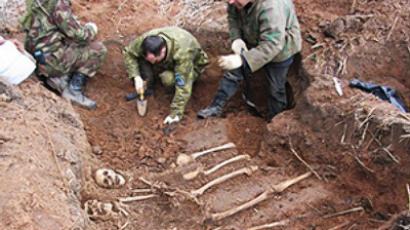World War II veterans commemorate battle over Sakhalin and Kuril islands
As part of worldwide commemoration of the 65th anniversary of World War II, veterans gathered in Sakhalin in Russia’s Far East to remember one of the last and most momentous operations.
After completing the two-week “Tour of Remembrance” in the Pacific Ocean, the Russian BDK-98 military ship docked at Sakhalin Island on Wednesday. Retired captain Fedor Polekayev was among a dozen Russian Pacific Fleet veterans on board during the trip that commemorated the end of World War II. 65 years ago he took part in a military operation at the Kuril Islands. Images of the night when his battalion disembarked on the Shunshu Island have still not left him, he says.
Germany’s capitulation in May 1945 did not spell the end of fighting for the Soviet Union. According to agreements reached between Stalin, Roosevelt and Churchill in Yalta, the Soviet Union entered the war on the Far Eastern front against imperial Japan in August 1945, kicking off the Kuril and the Sakhalin operations.
“It took almost three months to relocate the huge armada of the Red Army forces from Central Russia to the Far East,” said historian Igor Samarin. “The operation started on August 12, and in two weeks the island of Sakhalin was free of Japanese forces.”
However, this was not an easy task. Despite Japan already teetering on the brink of defeat, it resisted fiercely, applying the entire might of its army.
Survivors of the siege say the Japanese fought ruthlessly, but tactics used by the Soviet command in that battle won out over the opponent’s force.
To some extent, the Soviet Far East operation could be compared to the Blitzkrieg waged by Hitler in the first years of the Great Patriotic War.
“It was not about artillery strikes and lengthy assaults,” said World War II veteran Nikolay Sandler. “Marshall Vasilevsky ordered a swift dropoff. We caught [the Japanese] unaware and quickly managed to break through Japanese fortifications. After that, they were broken. They still defended well, but our offensive push could no longer be stopped.”
The operation turned out to be surprisingly brief, lasting just three weeks. On September 2, the peace treaty was signed on the USS “Missouri” battleship, ending World War II. By that time, the Sakhalin and the Kuril Islands were once again in Moscow’s grasp, where they remain to this day. Tokyo sometimes refers to the fact as the Russian occupation of these lands – something Russian historians find unjust.
“The Kuril Islands were traditionally Russian. They were gifted to Japan during a diplomatic exchange in 1875 and stayed under Tokyo’s control for several decades,” explained Samarin. “The same applied to Sakhalin, which was split in half by Russia and Japan. So according to all norms of international law, Tokyo has no valid grounds to claim these territories.”
While the entire world marks the 65th anniversary of the end of World War II, the holiday carries a different name in the Russian Far East. There, it is called the “Day of Liberation,” when locals commemorate 1,500 Soviet soldiers who died fighting to reclaim the land.













